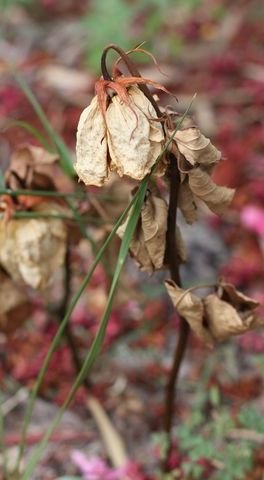Hawk Weed
Hawk Weed/Hawkweed (Heiracium sp.)
This is a winter perennial related to the sunflower family. There are many species of Heiracium. Some species are noxious, some are native to the United States, others are native of Europe and were introduced as ornaments and herbal remedies that now grow exotically.


The two species that we are most familiar with are non-native:
- Yellow (Heiracium pratense),
whose flower head is similar
to the dandelion.
- Orange hawkweed
(Heiracium aurantiacum).
For both, stems grow from a rosette cluster made of long, hairy leaves. If pulled, stem bleeds a white milky sap. At the top of each stem grows a cluster of flower heads, each flower growing anywhere from 1/2" to 1" in diameter.
| Photo: Elena Matchey-yelisav |
- The yellow weed has many similarities to orange but has yellow flower head with black hairs near the top. The yellow's stem can grow taller at anywhere from 6 - 36 inches tall.
- Orange can be a fire-orange weed with a reddish-yellow center flower head. The flower petals are so brilliant in color it is also known as devils paintbrush. The upright stem is hairy and leafless and grows anywhere from 6 - 20 inches.


Flowers bloom when spring begins to warm and continues throughout the summer then seeds begin to germinate in August. One is likely to see this weed growing densely in newly disturbed sites, but expect it to grow in moist pastures and open fields too.
Pollinators, including butterflies, are attracted to the bright flowers. A beginner gardener may want to incorporate this weed into natural gardening - don't!. These types of weeds are invasive and will crowd out native vegetation.
| Photo: Eva Grundemann |
Hawk weed has shallow roots and grows from rhizomes and stolons. Native species are likely to grow from rhizomes, where as non‐native species will grow from both rhizomes and stolons. Because the hawk weed family of species has started to hybridize, they can be very difficult to differentiate.
Hawk weed prefers slightly acidic, unmowed infertile soils. If pulling, the entire root must be removed from the soil, including runners.
One can hoe, or mow weed. This must be done regularly and will probably be ongoing for years until species begins to thin. Regardless of manual weed control methods, it is key to avoid spreading seeds and mulch heavily. Try boiling water to eliminate germinating weed seeds in late summer into fall.
Use a dicamba or other post-emergent, preferably a selective, and mulch heavily. Any post-emergent herbacide will be most effective in the spring and early summer.
Improving the acidic soil quality also helps discourage this and other invasive weeds from growing.
FYI:
In the 18th century when sundials couldn't work without sun on cloudy days and time pieces were very expensive, Carl Linnaeus, author of Linnaean taxonomy and father of modern plant classification, came up with the idea of a flower clock.
Flowers and flowering weeds open different times of the day and during different seasons. With this, the outdoor clock was designed to make sure people got to work in time. Because it was designed with the specific purpose of helping to tell the time of day, there were actually more weeds rather than flowers in the clock.
Hawk weed opened at 8:00 A.M. Unfortunately that was 8:00 A.M. Sweden time, where Linnaeus lived. A good idea that never took for the rest of the world.
Related Articles:
Back from Hawk Weed to home page Easy Butterfly Garden
 Copyright © 2010-2022 Easy-Butterfly-Garden.com
Copyright © 2010-2022 Easy-Butterfly-Garden.com
Privacy Policy Disclaimer

Join Easy Butterfly Garden on Facebook
Recent Articles
-
Mulch Types
Aug 02, 16 03:49 PM
Mulch types for natural weed control are detailed along with cross-over options that can also amend garden soil. This page helps in choosing the best mulch option for gardeners needs.
-
Butterfly Garden Building with Easy to Understand Resources
Jul 29, 16 09:41 PM
Easy Butterfly Garden is designed for the beginner gardener but others can benefit as well. Each page is easily detailed with subjects from DIY tips for gardening to common gardening problems.
-
How to Test Your Soil
Jul 24, 16 10:40 PM
Before spending any money here are a few simple ways how to test your soil giving ideas of soil types when starting a garden. Other options are purchasing soil testing kits, along with other options.
-
Soil Testing Methods
Jul 24, 16 10:30 PM
A home soil test kit vs. professional soil testing methods? Both are used in testing soil pH. One gives basic information and the other details your garden soil nutrients.
-
Post Emergent Weed Control
Jul 24, 16 09:35 PM
Post emergent weed control is one of two categories for herbicides. The second is pre-emergent herbicide.







New! Comments
Have your say about what you just read! Leave me a comment in the box below.